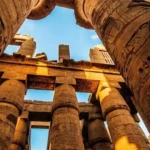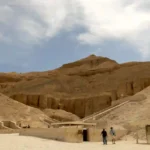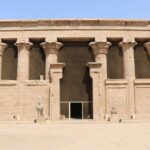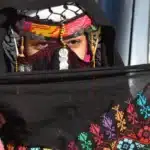“I’m planning a Nile cruise from Luxor to Aswan. The itinerary includes Kom Ombo Temple, but I’ve never heard of it. Is it really worth stopping for? Won’t it just be another temple—similar to Luxor and Edfu? Should I skip it to have more time in Aswan or spend extra time at the bigger temples?”
This is the question thousands of travelers ask before their Egypt journey. And it’s understandable. Time on a Nile cruise is precious. You have limited hours. You want to make every moment count.
Here’s the hard truth: Skipping Kom Ombo Temple would be a critical mistake.
Not because it’s the grandest or most visually impressive—it’s not. Luxor Temple is more imposing. Edfu Temple is more massive. Abu Simbel is more monumental.
But Kom Ombo Temple does something no other temple on the Nile does: it reveals how the ancient Egyptians actually thought.
This single insight transforms how you understand every other temple you visit. It reframes your entire Egypt journey from a checklist of monuments into a coherent spiritual and philosophical narrative.
Kom Ombo Temple isn’t a side attraction. It’s the keystone that makes all the other temples meaningful.
What You Need to Know About Kom Ombo Temple?
Before we dive deeper, here’s what every visitor should know:
- Location & Access: Kom Ombo Temple sits on the east bank of the Nile, approximately 40 kilometers north of Aswan and 170 kilometers south of Luxor. It’s a standard stop on most Nile cruise itineraries (3–4 night Luxor–Aswan routes) and is typically visited as part of a broader temple tour, rarely as a standalone day trip.
- History & Construction: Built around 180 BCE during the Ptolemaic period, Kom Ombo Temple was commissioned by Ptolemy VI. This was an era when Greek rulers of Egypt were strategically blending Hellenistic and Egyptian religious traditions—and Kom Ombo Temple is the physical embodiment of that political theology.
- The Two Gods: The temple is dedicated to Sobek (the crocodile god of fertility and Nile floods) and Haroeris (also called Horus the Elder, the falcon-headed sky god and royal protector). Rather than competing for sacred space, they coexist in perfect symmetry.
- Unique Features: Unlike any other major Egyptian temple, Kom Ombo includes a medical temple complex with evidence of ancient surgical knowledge, a functioning Nilometer (Nile flood measurement system), and an ancient Egyptian calendar recording the sacred festivals of the year. The nearby sacred crocodile necropolis adds another layer of spiritual significance.
- Visiting Logistics: The temple is open from approximately 7 AM to 5 PM (verify with your cruise operator). Plan 1–2 hours for a casual visit, 2–3 hours for a thorough exploration with photography.
Turquoise Dahabiya offers 4-day Nile cruises from Luxor to Aswan with a guided visit to Kom Ombo Temple — the perfect way to explore its mysteries without the crowds.
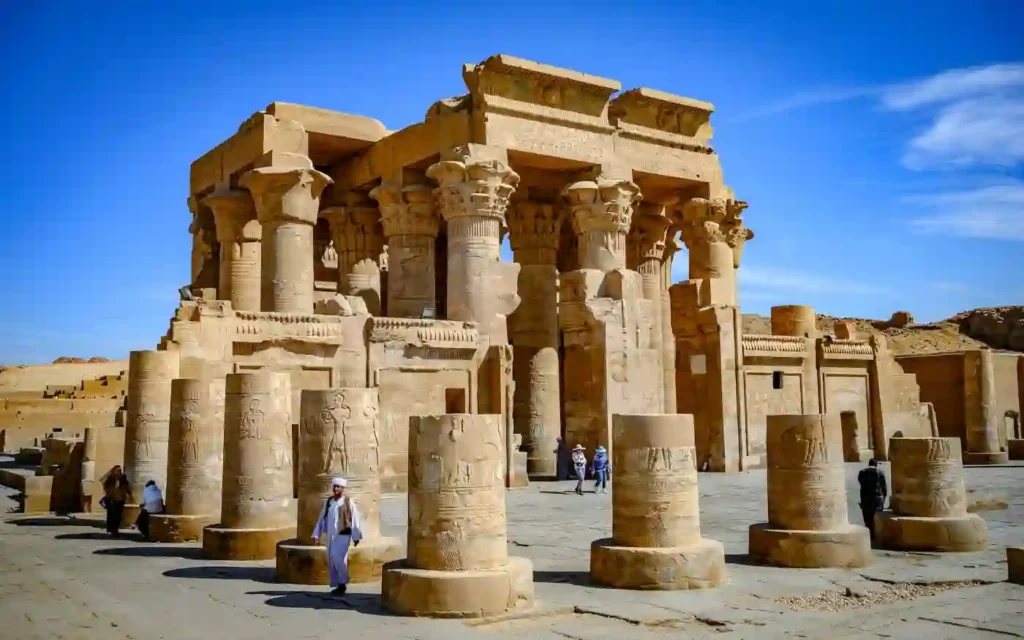
Kom Ombo Temple: Architecture of Duality
Why Two Gods? The Symbolism
To understand Kom Ombo Temple, you must first understand the Egyptian obsession with balance.
Ancient Egyptian cosmology was built on duality—opposing forces in constant equilibrium. Chaos and order. Sky and earth. Day and night. Life and death. The universe, in their view, thrived because of this tension, not despite it.
By the Ptolemaic period (around 180 BCE), when Greek rulers were consolidating power over Egypt, this dualistic philosophy became politically urgent. Ptolemy VI faced a simple problem: how do you unify a kingdom where different regions worshipped different gods, where Upper Egypt (the Nile Valley) had its own traditions distinct from Lower Egypt (the Delta)?
The answer: build a temple that honors both traditions simultaneously.
Sobek, the crocodile god, held deep roots in Upper Egypt and Nubia. Crocodiles were both terrifying and sacred—predators of the Nile, yet symbols of fertility tied to the annual floods that brought life-giving silt. Sobek represented chaos tamed, danger domesticated, the raw power of nature channeled into blessing.
Haroeris (Horus the Elder), by contrast, represented cosmic order and royal legitimacy. As a sky god, he embodied the divine authority of the pharaoh—the king was believed to be Horus on earth. Haroeris stood for civilization, law, and the sacred duty of rulers.
Together, they represented the eternal balance: wildness and order, fertility and kingship, the earthly Nile and the heavenly sky.
By placing them side-by-side in Kom Ombo Temple, Ptolemy VI was making a theological and political statement: I honor both your gods. Both traditions matter. Both are sacred.
Our 5-day Dahabiya cruise lets you visit Kom Ombo at dawn, when sunlight reveals the temple’s perfect symmetry and the Nile reflects its golden glow.
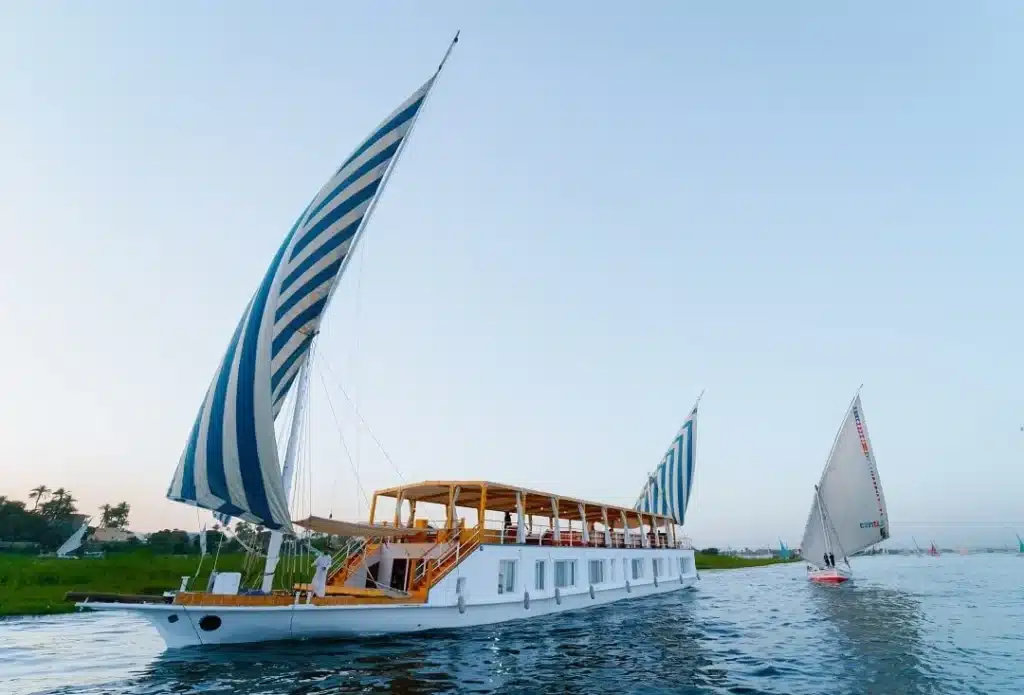
The Physical Layout: Mirror Image Design
Walk through Kom Ombo Temple, and you’ll immediately notice something unusual—it’s not asymmetrical like most temples. It’s perfectly, obsessively symmetrical.
The temple is literally split down the center by an invisible axis. Everything on the left mirrors everything on the right.
- The Entrance Pylon: A single, unified facade greets you—this is the one moment where duality becomes unity. Reliefs show Ptolemy VI offering to both gods, establishing his dual piety from the outset. But once you pass through, the temple divides.
- The Open Courtyard: You enter a symmetrical courtyard lined with columns. The architecture here still feels unified, but your eye begins to sense the division. The courtyard was where crowds gathered for festivals and public ceremonies—a space where both communities could witness the sacred simultaneously.
- The Hypostyle Hall (Double Columns): This is where the architectural genius becomes apparent. A forest of columns creates two parallel halls, one for each god. As you walk forward, you can literally choose a path—follow the left colonnade toward Sobek, or the right toward Haroeris. The columns themselves are identical in design, yet their reliefs tell different stories. On one side, crocodiles and fertility symbols. On the other, falcons and celestial imagery.
- The Twin Sanctuaries: Deep within the temple, cordoned off but visible, are two separate inner sanctums. Each is identical in size and layout but oriented in opposite directions. This is where the daily rituals took place—priests entering one sanctuary to make offerings to Sobek while their counterparts performed identical rites in the Haroeris sanctuary. Two priests, two gods, one moment of synchronous worship.
- The Astronomical Ceiling: In some chambers, if you look up, you’ll see one of Kom Ombo Temple’s most remarkable features—a ceiling decorated with zodiac symbols and stellar bodies. The ancient priests were aligning this temple not just with the gods, but with the heavens themselves.
Unique Features Only Kom Ombo Temple Has
Beyond its dual design, Kom Ombo Temple harbors several features found nowhere else in the Nile Valley.
The Medical Temple: In an adjoining chamber, ancient Egyptians left evidence of sophisticated medical practice. Stone reliefs display surgical instruments—scalpels, forceps, probes—eerily modern in design. Hieroglyphic texts describe treatments for fractures, eye diseases, and other ailments. This wasn’t superstition; this was empirical medicine. The presence of this medical sanctuary suggests Kom Ombo Temple functioned as a healing center, a place where sick pilgrims came seeking both spiritual and physical restoration.
The Nilometer: Descend a set of ancient stone stairs, and you’ll reach a chamber that opens directly onto the Nile. This is the Nilometer—a flood measurement system used by priests to predict annual inundation levels. Markings on the walls indicated safe water levels, drought warnings, and bountiful flood years. By controlling water knowledge, the priesthood controlled prophecy and power. The Nilometer at Kom Ombo Temple is one of the few still-intact examples.
The Sacred Crocodile Necropolis: Outside the main temple stands a museum housing mummified crocodiles—some as small as juveniles, others massive alpha predators preserved in stone sarcophagi. These weren’t trophies; they were sacred animals ritually buried. Pilgrims would bring crocodile mummies as offerings to Sobek, a practice that continued for centuries. Seeing these preserved creatures, thousands of years old, creates an eerie sense of continuity—ancient devotion literally crystallized in time.
Experience Kom Ombo’s sacred mysteries as part of our exclusive 4-day Dahabiya cruise — a journey through history, comfort, and tranquility.
Visiting Kom Ombo Temple: A Complete Guide
Best Time to Visit Kom Ombo Temple
Timing matters at Kom Ombo Temple—not just for comfort, but for experience.
- Early Morning (6:00–8:00 AM): This is the golden hour. The sun rises from the east, illuminating the temple’s facade in warm, honeyed light. Shadows are long and defined, making reliefs pop with dramatic contrast. Crowds are minimal—you might have entire colonnades to yourself. Temperatures are cool (especially October–April), making walking through the hypostyle hall a pleasure rather than an endurance test.
- Late Afternoon (4:00–6:00 PM): The second-best option. Light softens, creating a more diffuse glow. Temperatures begin to cool. However, most tour groups visit in late afternoon, so expect crowds—especially during peak season (December–February).
- Midday (10:00 AM–3:00 PM): Avoid if possible. The sun is harsh and directly overhead, creating blown-out whites and deep shadows that obscure carved details. Temperatures soar, particularly June–August when midday heat can exceed 40°C (104°F).
Seasonal Considerations:
- October–April: Ideal. Temperatures range 22–30°C, light is crisp, and photography is stunning. December–January are peak season—expect crowds and higher prices.
- May–September: Heat is intense. Daytime highs can exceed 38–42°C. Crowds thin dramatically, and prices drop. If you visit in summer, plan tours for sunrise (5:30–7:00 AM) or late afternoon (5:00–6:30 PM), then retreat to your cabin for a siesta during midday heat.
How Long to Spend at Kom Ombo Temple
Quick Visit (45 minutes–1 hour): Walk through the main courtyard and hypostyle halls, photograph the key reliefs, visit the crocodile museum. This is typical for Nile cruise passengers with set schedules.
Thorough Exploration (2–3 hours): Hire a local Egyptologist guide (highly recommended). Explore both sanctuaries, study the astronomical ceiling, descend to the Nilometer, examine the medical temple, and absorb the symbolic layering. This pace allows you to genuinely understand Kom Ombo Temple’s architecture and theology.
Photography-Focused Visit (2–3 hours): Arrive at sunrise, shoot through golden hour, rest midday, return for late afternoon light. This requires flexibility—typically not available on standard Nile cruises, but possible if you’re staying in Aswan or Luxor.
Nile Cruise vs. Day Trip: Which Is Better?
- Dahabiya Cruise (The Best Option): A Dahabiya is a traditional Egyptian sailing vessel—smaller, more intimate, and more luxurious than standard Nile cruise ships. A 4–7 night Dahabiya sailing from Luxor to Aswan includes Kom Ombo Temple as a carefully timed stop, usually arriving at dawn or early morning when light is perfect. Advantages: maximum flexibility in scheduling, intimate group size (15–30 guests vs. 150+), personal attention from Egyptologist guides, the authentic experience of traditional Nile sailing, and the ability to adjust itineraries based on light, crowds, and your preferences. Dahabiyas often anchor directly at temple sites, giving you direct access without crowded tourist infrastructure. You experience the Nile as ancient pilgrims did—by water, at a human pace. Worth every penny for the experience quality and Kom Ombo Temple access.
- Nile Cruise (Standard): This is how most visitors experience Kom Ombo Temple. A 3–4 night Luxor–Aswan cruise typically includes Kom Ombo as a scheduled stop on day 2 or 3. Advantages: your timing is set by the cruise operator (often favorable), you have onboard Egyptologist guides, the experience is immersive, and you visit multiple temples in sequence (Luxor → Edfu → Kom Ombo → Aswan). Disadvantages: less flexibility, crowded, and you’re bound to the ship’s schedule.
- Day Trip from Aswan: Possible but less common. You’d rent a private car and driver (2–3 hours each way), giving you schedule flexibility. However, you miss the Nile experience and the narrative arc of visiting multiple temples.
- Day Trip from Luxor: Not practical—Kom Ombo is 170 kilometers south, requiring 3+ hours of driving each way.
If you want to experience Kom Ombo as ancient travelers once did, there’s no better way than aboard the Turquoise Dahabiya. This handcrafted luxury sailboat offers 5-day Luxor to Aswan and 4-day Aswan to Luxor cruises, letting you explore temples and villages at a peaceful rhythm, far from the crowds.
What to Bring & Wear
Clothing:
- Light, breathable fabrics (cotton, linen) that allow air circulation
- A light wrap or shawl for evening temperatures, especially October–April
- Comfortable walking shoes with grip (stone floors can be uneven and slippery)
Sun Protection:
- Wide-brimmed hat or baseball cap
- Sunscreen
- Sunglasses
Essentials:
- Water bottle.
- Snacks (fruit, nuts, energy bars)
- Camera and tripod (for sunrise/sunset photography)
Photography Guide: Capturing Kom Ombo Temple
Kom Ombo Temple is a photographer’s dream—symmetrical, dramatic, and beautiful at nearly every hour.
Golden Hour Magic: When to Shoot
- Sunrise (6:00–7:30 AM): Hands down the best time. The sun rises from the east, bathing the temple’s eastern face in warm, golden light. Shadows are long and defined, making carved reliefs—especially the hieroglyphic texts and god figures—pop with stunning three-dimensionality. Colors are warm (golds, ambers, pale greens). Crowds are virtually nonexistent. The Nile, still and mirror-like at dawn, reflects the temple’s facade.
- Sunset (4:30–6:00 PM): Similar magic, but expect crowds. The light is warmer and more diffuse, creating softer shadows. Less dramatic contrast than sunrise, but more romantic.
- Avoid Midday (10 AM–4 PM): Harsh overhead sun creates blown-out highlights and crushed shadows. Reliefs become flat and impossible to photograph. The heat is punishing, and crowds are largest.
FAQ: Kom Ombo Temple Questions Answered
What makes Kom Ombo Temple unique compared to other Egyptian temples?
It’s the only major temple in Egypt dedicated to two gods equally—Sobek and Horus—featuring a perfectly symmetrical, dual design.
What time of day should I visit Kom Ombo Temple?
Visit early morning (6–8 AM) for cooler weather, soft golden light, and fewer crowds.
How long does a typical visit to Kom Ombo Temple take?
Most visits take about 1–2 hours; guided tours with the museum and Nilometer may need up to 3 hours.
Can I visit Kom Ombo Temple as a day trip from Luxor or Aswan?
Yes, but it’s best visited on a Nile cruise. From Aswan it’s 1.5 hours each way; from Luxor, over 3 hours.
Is Kom Ombo Temple worth visiting if I’m also seeing Luxor and Edfu temples?
Definitely. Kom Ombo’s twin-god design makes it uniquely different from Luxor’s grandeur and Edfu’s single-god focus.
What was the medical temple at Kom Ombo Temple used for?
It served as a healing center where priests performed treatments; carvings show ancient surgical tools and medical practices.




